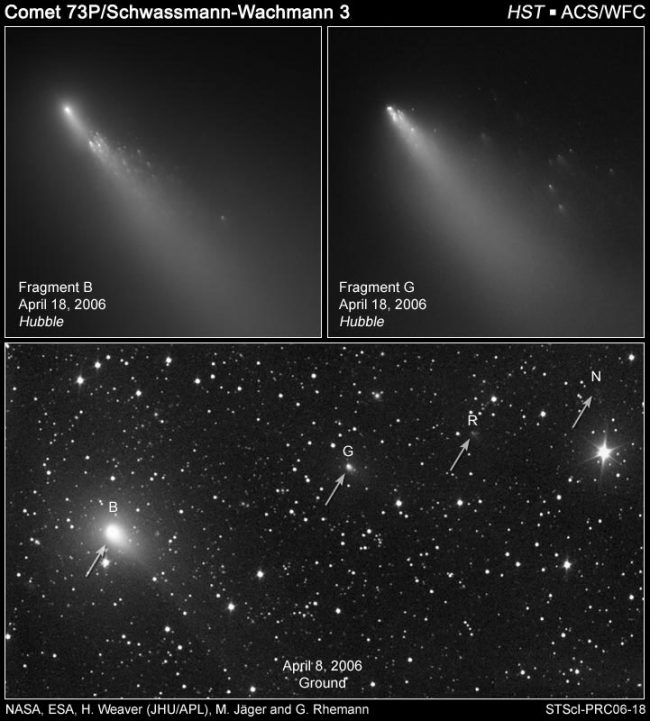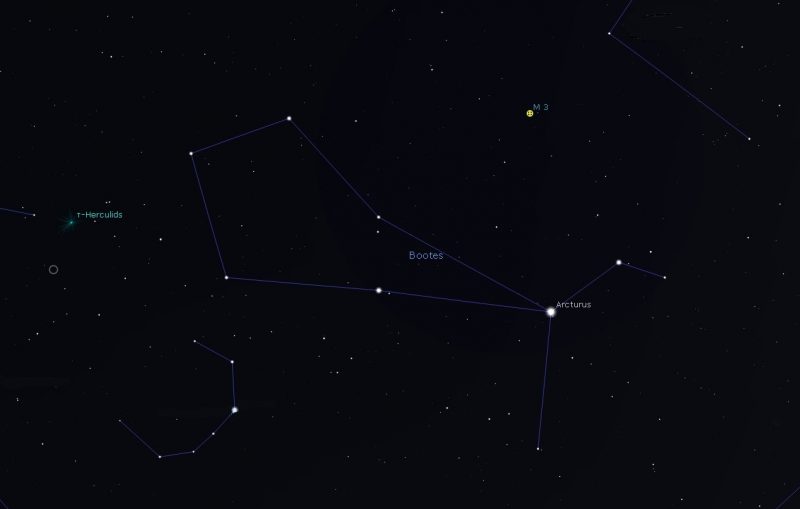
Intense meteor display possible from comet SW3
Heads up! On May 30-31, 2022, we might have a brief-but-intense meteor display, thanks to a comet that split apart in 1995 and is apparently still fragmenting. It might happen, as Earth passes through a particularly dense stream of icy particles which the comet left behind in the years 1995, 1897 and 1892.
If it does happen, we’ll see a grand display of meteors! And, even if it doesn’t, this comet is one you’ll want to come to know.
The meteor shower is the Tau Herculids. Its parent comet is 73P/Schwassmann-Wachmann, aka SW3. Astronomers found this comet in 1930. It orbits the sun every 5.4 years. And the comet will be in our evening sky again, in July and August 2022. It’s not an intrinsically bright comet. But it’s an exceptionally interesting comet. In 1995, astronomers watched as this comet began to fracture and litter its orbit with an increasing amount of debris.
That’s why, by some recent calculations, the May 2022 Tau Herculid meteor shower – spawned by SW3 – might be an intense display.
A fractured comet
Arnold Schwassmann and Arno Arthur Wachmann of Hamburg Observatory discovered two comets before this one (SW1 in 1927 and SW2 in 1929), not while looking for comets, but instead while conducting a photographic search for asteroids, or minor planets.
They found SW3 on May 2, 1930.
But, after its initial discovery in 1930 – despite its relatively short orbit around the sun – no one saw the comet again until 1979. Why not? Astronomers missed SW3 partly because of its intrinsic faintness. And the astronomers were also looking in the wrong place in the sky. Their inaccurate orbital calculations were due to occasional close sweeps of this comet past the giant planet Jupiter. The close passes near mighty Jupiter had changed the comet’s orbit.
And then … people began to see the comet again. With the exception of 1985, astronomers have caught it on every return near the sun since 1979.
In 1995, comet SW3 suddenly brightened by a factor of nearly 7 magnitudes. In other words, the comet suddenly got about 600 times brighter. For a while, it could be seen with the unaided eye.
A month after this outburst, observers using telescopes noticed that the nucleus, or core, of SW3 had split into pieces. They ultimately determined the comet split into four parts, with two parts disintegrating and two parts remaining, still following the original comet’s orbit around the sun.
2006 return: 68 comet pieces
By 2006 two things had become clear. First, the comet had by then fragmented into at least 68 pieces.
Second, it was still falling apart.
And that’s where the story of the possible Tau Herculid meteor shower in 2022 gets even more interesting, for earthly observers.
What can we expect at the comet’s 2022 return? We don’t know yet what we’ll see when the comet comes back this year.
Comet 73P/SW3 returned in 2011. But it wasn’t well-placed for observers that year, as it stayed mostly behind the sun. So we didn’t learn from that passage.
In 2017, astronomers observed the main component (C), along with one new fragment (BT).
The nuclei or multiple cores of this comet are small. For instance, the largest part, component C, is only about 0.6 miles, or 1.0 km, in diameter. That’s in contrast to a typical comet nucleus, which is about 6 miles (10 km) wide.

Will Tau Herculid meteors wow us in 2022?
For there to be a good meteor shower in 2022, three pieces of the puzzle must fall into place.
First, a large number of particles must have been expelled from the comet’s nucleus during its 1995 breakup. This appears to be true, as images taken at that time indicate.
Second, the breakup of the comet would have had to eventually push the material forward in its orbit. As a comet orbits the sun and ejects material, let’s assume that particles go in all directions. Those pushed backward will assume a slower speed and – governed by the laws of gravity – they’ll fall closer to the sun. Since they’re now closer to the sun, they will speed up. And, in time, they’ll pass by the comet on their smaller orbits and get ahead of the comet. Images from the 2006 passage of the comet show:
… Large chunks in a temporary orbit behind one of the larger fragments.
Finally, the comet must eject the material at a speed fast enough to assume this new orbit. A speed of about 60 miles per hour (26.71 m/second) is necessary to pull this off. This is faster than typical, but the major outburst and breakup of the comet’s nucleus in 1995 might have been strong enough to produce this speed.
If all three of these conditions are met, we will have the perfect storm.
The radiant for Tau Herculid meteors
This meteor shower – the Tau Herculids – got its name in 1930 when the parent comet for this shower flew by, very close to the earth. It’s said that some observers saw a short-lived meteor shower in 1930. But that claim has been disputed.
Since then, the shower has been either non-existent or lackluster, although it’s still on the meteor shower list of the American Meteor Society, which gives its duration as May 19 to June 14.
Most meteor showers take their names from the point in the sky from which they appear to radiate. And this shower will probably be forever known as Tau Herculids. That was the location calculated when the comet was discovered in 1930. But, oddly enough, observers have never seen any meteors from this comet radiate from this location in our sky. Due to gravity of our giant planet Jupiter, the radiant has wandered.
It is now located in western Boötes, near the bright star of Arcturus, close to a globular star cluster M3.

How to watch the shower: Timing will be everything
In 2022, the moon will be new the day before the shower’s predicted peak. So – luckily – the moon will not be a factor in this event.
Calculations by different teams have provided three different peaks, all within a 22-minute time span. The most recent one places the peak at 05:04 UTC on May 31, 2022. For much of the Western Hemisphere, this translates to Monday night, May 30-31. It would be 10:04 p.m. PDT (North American west coast), 11:04 p.m. MDT, 12:04 a.m. CDT early on the morning of May 31 (central North America), and 1:04 a.m. EDT on May 31 (eastern North America). Translate 5:04 UTC on May 31 to your time zone.
The other two teams produced similar times: 04:55 UTC and 05:17 UTC.
Alert observers might also see meteors from previous visits of the comet, but with less activity than that expected from the 1995 breakup. A slight increase in meteor counts might occur anytime between May 28 and June 1. Dust from the comet’s 1892 and 1897 visits may appear in our sky between about 16:00 UTCMay 30 and about 10:00 UTC on May 31.
The radiant will be high in the sky for much of northern and central North America. But from the northwestern United States and much of Canada, with the sun far north of the equator in late May, it will be twilight during the peak of the shower.
What will the Southern Hemisphere see?
The radiant will be above the horizon for all of South America during the peak of the shower.
But the radiant will be lower in the sky as seen from the Southern Hemisphere than from North America. So the number of meteors will be fewer than if observed from further north. On the other hand, with the radiant low in the sky, observers might spot some earthgrazers, long-path meteors traveling through the sky from the radiant.
How to watch the shower: A dark sky is essential
This potential meteor shower will be short-lived, so don’t be late to the star party. Find a dark site from which to observe. Take time to get dark-adapted.
Note that these meteors will be slow-moving, as they will have to catch up with us as we orbit the sun. With their slow motion, the meteors will be dimmer than they would be if they were moving faster in relation to our Earth. Meteors from this shower will trace back to the radiant area. You will see other meteors too; if they do not appear to come from the radiant, they are not members of the Tau Herculids meteor shower.
The meteors will appear to travel away from the radiant in the sky. That does not mean they’ll be only in that part of the sky. You’ll likely see the greatest number of meteors while watching about 45 degrees from the radiant and about 45 degrees high in the sky.
If you have a telescope, look for Comet SW3, located 47 degrees west of the meteor radiant. It’s in the part of the sky occupied by the constellation Leo. The comet will be faint, at magnitude 11.
Will we get a wonderful meteor display? We never know for sure. EarthSky readers are encouraged to go out and see for themselves, in real-time, on May 30-31, 2022. A strong meteor shower or a meteor storm will be memorable. If no shower develops, you’ll be among the first to know!
Any time spent under the nighttime sky is never time wasted.
Bottom line: Comet 73P/Schwassmann-Wachmann’s 1995 outburst and breakup may produce a wonderful meteor shower on May 30-31, 2022.
The post Tau Herculid meteors in May might be intense! first appeared on EarthSky.
0 Commentaires